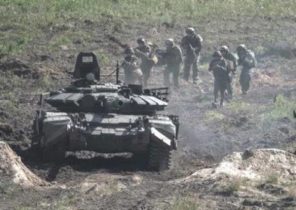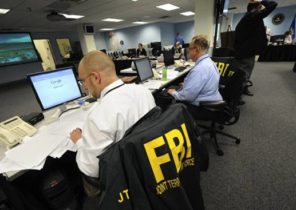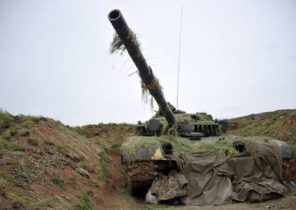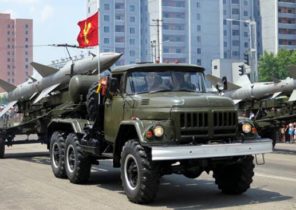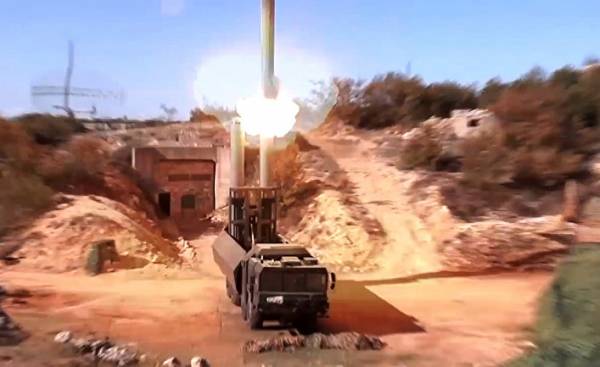
Chinese bubbles interdiction of access/blocking zone in the South China sea have become a real headache for the US and its allies in the Asia-Pacific region. And to the North of Russia creates its own “bubble” of A2/AD against Japan on the disputed Kuril Islands. Meanwhile, at the other end of Eurasia in the Russian Kaliningrad region was a district of the interdiction of access/blocking zones that threaten the position of NATO in Eastern Europe.
Russia now there are “bubbles” of A2/AD in the Black sea and in Syria defying Turkey and South-Eastern flank of NATO.
These Russian “bubbles” interdiction of access/blocking zone in the Black sea and in Syria pose serious challenges for Turkey for several reasons. They portend an end to the relative naval superiority, which Ankara has created in the Black, Aegean and Eastern Mediterranean seas after the end of the cold war. Turkey is also forced to retarget resources, abandoning an ambitious plan to create platforms for the projection of military force and turning to the formulation of strategies and weapons systems to counter the Russian forces and means A2/AD. In recent months relations between Russia and Turkey improve, but their Outlook is very uncertain. If a crisis would occur in November 2016, when the Turkish F-16 shot down a Russian su-24, Ankara will be very difficult to survive in the confrontation with Moscow.
Bear is setting up new digs in the Black sea and the Eastern Mediterranean
In may 2014, Russian defense Minister Sergei Shoigu announced the allocation of $ 2.43 billion for the development of the Navy. The plan provides for deployment by 2020, a new anti-aircraft missile systems, land-based, as well as the construction of surface ships and submarines in order to strengthen the black sea fleet.
Moscow has started implementation of the naval component of its new black sea strategy, and Vladimir Putin in March 2015, made a statement that Russia deployed in Crimea coastal missile systems “Bastion” with anti-ship missiles. 12 August, RT reported that on the Peninsula also contains the most modern in the Russian Arsenal is antiaircraft-rocket complexes With-400 “Triumph”, which strengthened a formidable and powerful system s-300V4 and self-propelled anti-aircraft missile and gun complexes “Carapace C-1”. In the Crimea, carried out major repairs and upgrading of underground shelters of the Soviet era, recovered radar equipment for early warning is the high-tech equipment for electronic warfare, making the Peninsula became the epicenter of a virtually impregnable zone of interdiction and preventing access to the Black sea.
Air defense ground-based anti-ship systems as well as radar for early detection, which is an integral part of the strategy A2/AD, given the small size of the black sea fleet impressive in its range of defensive and offensive capabilities. In September, the chief of the Russian General staff Valery Gerasimov rightly declared that his country regained its superiority in the Black sea that was lost in the late 1990s and given to Turkey. In an effort to highlight the effectiveness of the current strategy of interdiction of enemy action at sea, Gerasimov said, “the black sea fleet must be capable of — and he showed that he is capable of — their means to impress the troops during the extension, starting from the port of loading”. He further said: “today’s black sea fleet has it all: intelligence, which detect targets at ranges up to 500 kilometers, and the means of destruction.”
A thousand kilometers further South, off the coast of the Syrian port city of Tartus, the picture is almost the same. Carrier strike group led by “Kuznetsov”, despite her serious air defense and anti surface ships, under cover of the powerful coastal missile complexes “Bastion” with anti-ship long-range missiles, anti-aircraft missile systems s-300 and s-400, as well as cruise missiles of air basing.
The land dominates the sea, the defense overpowers offensive
Russian is not without reason, increasing the grouping of forces and means A2/AD ground-based to support its fleet. Like the Chinese, Russian military strategists have learned the right lessons from the Gulf war, applying the principles of interdiction of access/blocking zone. This system does not allow enemy forces to enter the conflict area, and to act and stay there.
A characteristic feature of such naval strategy are fighting with the use of missiles and coastal defence systems that have the advantage of a fleet, but it does not have its drawbacks. For this reason, they play a prominent role in the conduct of hostilities in the coastal zone. In the event of hostilities in the coastal area, numerous anti-ship cruise missiles and anti-aircraft missiles can very efficiently and economically increase the firepower of the fleet or to inflict decisive blow at the enemy ships and give their naval forces the ability to fight the enemy in more favorable conditions.
According to a famous military strategists such as Wayne Hughes (Wayne Hughes) and James Holmes (James Holmes), the concept of A2/AD should be implemented within the framework of naval strategy through the creation of “Navy fortress”, reinforced by mine-layers, submarines, air support, land-based, antiship cruise missiles, anti-aircraft missile systems and electronic warfare. In this case, it turns into the most cost-effective, efficient and compelling method of establishing control over the coastal area and nearby seas.
Recent developments have confirmed the advantages of A2/AD. In October 2016, which enjoys Iranian support for the Yemeni rebels, the Houthis inflicted a series of missile strikes against U.S. destroyers of the “Arleigh Burke”. They demonstrated that the leading defense on land troops can cause serious damage even obsolete missiles. The incident in Yemen showed that the attacked ships are able to leave the area of the attack without a scratch, however, an effective defense can be prohibitively expensive for the navies of many countries. The stakes are so high that hardly anyone will want to take the risk, choosing the path of least resistance.
Theory and practice of modern naval warfare shows that in coastal areas, fleets are much harder to control the situation at sea, to transfer troops and military equipment, to demonstrate military power and to strike at ground targets. The reason is that to solve these tasks it is necessary to concentrate large forces and means, especially the defensive anti-aircraft systems shipborne. This problem becomes even more urgent for the Turkish Navy, which has ports and coastal areas within reach of new means of access interdiction/blocking zone.
In addition, the Russian “bubbles” A2/AD pose a threat to the Turkish trade routes. The economic prosperity of Turkey is very much dependent on foreign trade, and if the Russian zone of interdiction/blocking in Syria to deter it in the future can create a very serious threat to Turkey.
Why Turkey needs to change its naval priorities
The naval strategy of Turkey in countering the Russian threat is based on assumptions and assumptions from the era when the Navy of this country had relative naval superiority, which Ankara has created in the Black, Aegean and Eastern Mediterranean seas. Turkish naval strategy is currently aimed at protecting the territory and to neutralize threats to the rights and interests of Turkey in the peripheral seas. Accordingly, the main task of the Turkish Navy is to establish control of the sea space (although Ankara does not say anything whether this control is absolute or limited). The tasks of the second and third order consist in the sending of forces and means, as well as in the strikes on land from the sea. Isolation of the marine area is only in fourth place.
This concept determines the nature and content of the modernization projects of Turkish Navy. Currently, Turkey has to think about major purchases in order to create a powerful organizational structure of the fleet, which is largely influenced by the doctrine of “sea power” the American Admiral Mahana. Plans, Turkey aimed at establishing the domination of the seas and projecting power. To this end, it plans to develop and build the stealth frigates of class I (at its core it is the corvettes project “Inferno”, but the large size), equipped with 16 anti-ship missiles; air defense frigates, TF-2000, two landing helicopter on the basis of the Spanish amphibious assault ship “Juan Carlos I” (each worth one billion dollars with the possibility of placing the F-35B), as well as high speed squadron transports supplies.
But Turkey must also be realistic about the grim picture for her. On the Black sea, the balance of power is clearly tipped in favor of Russia, which in the fleet are (and are constructed) surface ships invisible, such as patrol ships of the series “Admiral Grigorovich”, modified small missile ships of the “Buyan-M” and diesel-electric submarines of the project “warszawianka” (the sixth and last boat of this type recently transferred to the fleet). In addition, Moscow is becoming increasingly unpredictable and aggressive, and close to the creation of two very powerful areas of A2/AD, which will join Turkey to the South and the North, severely limiting its ability to manoeuvres at sea and in the air. In this regard, the Turkish side you must reformat its naval strategy, and create your own forces and means of preventing access/blocking zones to establish control at sea.
In today’s environment the control of Maritime space is a very costly and onerous task for the Navy, especially in narrow and semi-enclosed seas and coastal waters that surround Turkey. Unless unexpected breakthroughs in the military, and will not appear unique anti-missile system (such as an effective directed energy beam weapon), the strategy of A2/AD with its forces, ground-based and serious opportunities to strike with a solid defeat will defeat the concept of naval defence.
The good news is that Turkey has made some progress in creating weapons that can be used to establish a zone of interdiction/blocking access. Turkish military industry has long been developing domestic anti-ship and cruise missiles of air basing. For the first type of missile since 2009, work is underway in the framework of the project ATMACA (Hawk). The aim of the project is to create a domestic anti-ship missile with the same characteristics and range as the Harpoon Block II, which is scheduled to be removed from Turkish surface ships and submarines.
As for cruise missiles of air basing, a Turkish ammunition to hit targets without entering the air defense zone (model-1) has a range of 180 kilometers and is equipped with an automatic imaging infrared seeker that can detect targets, which gives him the ability to hit moving surface targets. These missiles already installed on the aircraft of the Turkish air force F-4E 2020 Terminator and F-16 Block 40. In addition, now create a version of the missile extended range and a model with improved stealth characteristics, which is scheduled to be placed in the inner compartments F-35.
These innovations make a good impression, but not enough of them. Turkey should discover the combat potential of the winged long-range missiles and on this basis to develop a realistic and cost-effective naval strategy. She should invest in the development of coastal missiles with a launch range of up to 300 kilometers, as well as mobile launchers and systems for the detection and tracking of targets. Unlike anti-aircraft and anti-missile systems, Turkey has necessary technical capabilities to quickly create and launch serial production of high-precision anti-ship cruise missiles.
Taking into account the geographical position of Turkey — a narrowing between the Black and Mediterranean seas and the longest coastline along the narrow and semi-enclosed seas, mobile land-based weapons and detection devices significantly strengthen the Turkish Navy. It is equally important to create an integrated air shield large and small range. With such a collection of toys, Turkey will be practically able to close their coastal waters to penetrate any enemy, and create a threat to him and to conduct harassing actions in the Aegean sea in the Eastern Mediterranean and in the southern half of the Black sea.
A2/AD: the last reliable protection in our chaotic world
Whatever Russian intentions (or the last vestiges of Turkish-Russian rapprochement), Ankara has many reasons to create and strengthen their own system of A2/AD.
First, in these times of rapid technological advances and uncertainty in the strategic environment, Turkey needs careful and defensive military strategic concept. Uncertainty posed by the new US administration the prospects of NATO, and changes in the situation on the Turkish border require the speedy creation of a “bubble” interdiction of access/blocking zone. This bubble will allow Turkey to deny the existing to the detriment of its national interests of the country the possibility of penetration into its coastal waters and airspace.
A reliable system of A2/AD will also give Turkey the opportunity to respond to criticism of trump is sounded during election campaign when he said that NATO allies must contribute to the common Fund, increasing military budgets, and not to use for nothing security guarantees from the United States. Therefore, Turkey with its NATO allies should strive to create their own shield A2/AD, reinforcing in this way their defense and the defense of the West.
Of course, we cannot ignore the weakening of Turkey’s relations with its NATO partners after a failed coup attempt in July 2016. Justified is Western criticism of Turkey about the weakening of democracy in the country, and the Turkish criticism of the US and Europe because they do not help Ankara to resolve its security concerns emanating from Iraq and Syria. But these concerns should be considered in comparison with more important strategic interests of the West and Turkey to the Mediterranean, the Caucasus and the middle East. In other words, political leaders in Ankara, Washington, Brussels and other Western capitals have to ask yourself, is it lawful for them to “lose” each other in the period when the world situation is becoming increasingly chaotic and dangerous.
And if relations between Ankara and the West will seriously deteriorate the system A2/AD will become even more important. For example, if renewed disputes between Turkey and Greece in the Aegean sea and Cyprus, the Greek Navy is quite unable to support the Navy of the European countries-members of EU. In this case, the benefits of Turkish weapons systems, is intended for “power projection” will be very small. On the other hand, ground-based defensive system A2/AD will give Turkey a much-needed deterrent and will ensure the protection of its sea routes, which can not make costly and highly vulnerable system of “power projection”.
This means that we must abandon prestigious, but questionable from the point of view of strategy projects (especially from the amphibious helicopter carrier with a total value of two billion dollars) and invest in the system of A2/AD. In the current era, when even the mightiest aircraft carriers with a nuclear power plant and their battle groups are increasingly considered obsolete for solving problems of power projection, the situation in coastal waters and in coastal areas can change rapidly. Turkey should reconsider its naval priorities and focus on creating effective zones of interdiction/blocking access to the adjacent seas is the development of a costly offensive weapons systems of dubious effectiveness. As said by the Chinese strategist sun Tzu, “the skilled warrior first make himself invincible and then wait for a moment when his enemy is vulnerable”.
